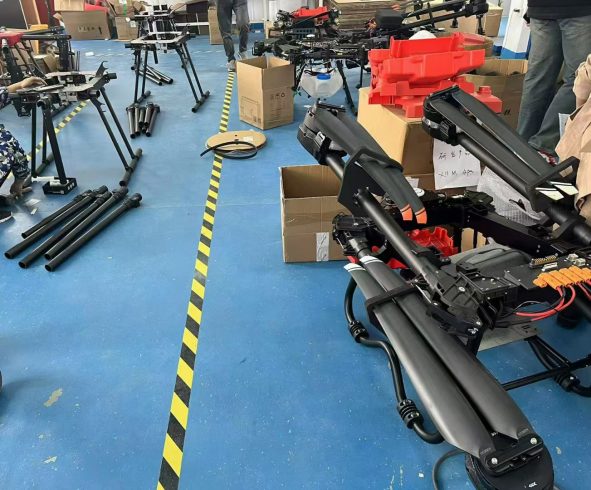![图片[1]-How Pesticide Spraying Drones Are Transforming Modern Agriculture-msoen](https://www.msoen.com/wp-content/uploads/2025/03/f7d159600e19.webp)
![图片[2]-How Pesticide Spraying Drones Are Transforming Modern Agriculture-msoen](https://www.msoen.com/wp-content/uploads/2025/03/bb40018735be.webp)
![图片[3]-How Pesticide Spraying Drones Are Transforming Modern Agriculture-msoen](https://www.msoen.com/wp-content/uploads/2025/03/1b9346e166da.webp)
![图片[4]-How Pesticide Spraying Drones Are Transforming Modern Agriculture-msoen](https://www.msoen.com/wp-content/uploads/2025/03/6294a90b8534-1024x576.jpg)
![图片[5]-How Pesticide Spraying Drones Are Transforming Modern Agriculture-msoen](https://www.msoen.com/wp-content/uploads/2025/02/0f1391077c98-1-1024x769.jpg)
![图片[6]-How Pesticide Spraying Drones Are Transforming Modern Agriculture-msoen](https://www.msoen.com/wp-content/uploads/2025/02/c270eb7dd0e8.jpg)
The landscape of modern agriculture is rapidly changing, with technology playing a crucial role in driving innovations. Among the most notable advancements are pesticide spraying drones. These high-tech tools are revolutionizing the way farmers approach crop protection, offering benefits in precision, efficiency, and environmental sustainability. In this article, we explore how pesticide spraying drones are reshaping the agricultural industry and their impact on farming practices.
What Are Pesticide Spraying Drones?
Pesticide spraying drones are unmanned aerial vehicles (UAVs) equipped with advanced spraying systems to apply pesticides, herbicides, and fertilizers to crops. These drones are designed to cover large agricultural areas efficiently, ensuring even application and reducing waste. With the ability to fly at low altitudes and navigate through fields autonomously, they offer a level of precision that traditional methods simply cannot match.
The growing adoption of drone technology in agriculture has been driven by the need for more sustainable farming practices. These drones not only make pesticide applications more efficient but also help reduce the negative environmental impacts associated with conventional pesticide spraying.
Key Benefits of Using Pesticide Spraying Drones
1. Increased Precision and Accuracy
Traditional pesticide spraying methods often lead to over-application, resulting in wasted chemicals and potential harm to the environment. Drones equipped with sensors and GPS technology can target specific areas of a field, ensuring that pesticides are applied precisely where they are needed. This precision reduces the risk of overuse and minimizes pesticide drift, which is the unintended spread of chemicals to nearby areas.
By controlling the volume and distribution of pesticides, drones help ensure that crops receive the appropriate level of protection, leading to healthier plants and improved yields.
2. Environmental Sustainability
Pesticide spraying drones contribute to sustainable agriculture by reducing the environmental footprint of pesticide use. With precise targeting, drones minimize chemical runoff into water sources and surrounding ecosystems. This reduces the impact on non-target species and helps maintain biodiversity.
Furthermore, by applying pesticides only when necessary, drones help reduce the overall amount of chemicals used in farming. This not only benefits the environment but also promotes healthier soil and air quality for future generations.
3. Cost Efficiency
While the initial investment in drone technology may seem substantial, the long-term savings are significant. Drones reduce the need for manual labor and the use of ground-based equipment, both of which can be costly. With drones, farmers can cover large areas of land in less time, increasing operational efficiency and lowering labor costs.
Additionally, the precise application of pesticides reduces waste, further improving cost efficiency. By using fewer chemicals, farmers can save money on supplies and reduce overall input costs.
4. Time-Saving and Improved Efficiency
In traditional farming practices, pesticide spraying can take a considerable amount of time, particularly on large farms. Drones, however, can cover vast fields in a fraction of the time, ensuring that crops are protected quickly and efficiently. This time-saving capability allows farmers to focus on other tasks, enhancing productivity across the farm.
With the ability to operate autonomously, drones can also work during off-hours, such as early mornings or evenings, when conditions are optimal for pesticide application.
Emerging Trends in Pesticide Spraying Drone Technology
The development of pesticide spraying drones continues to evolve, with new trends shaping the future of agriculture. Some of the key trends include:
- Artificial Intelligence (AI) Integration
AI and machine learning are enhancing the capabilities of pesticide spraying drones. These technologies allow drones to analyze field conditions in real time, adjusting their operations based on weather, terrain, and crop health. AI also helps drones optimize flight paths and ensure accurate pesticide application. - Advanced Sensors for Crop Health Monitoring
Modern drones are equipped with sensors that can assess the health of crops as they fly overhead. By collecting data on plant conditions, drones can detect early signs of disease, pests, or nutrient deficiencies, allowing farmers to take proactive measures before issues become widespread. - Collaborative Drone Swarms
In some regions, multiple drones are working together as part of a swarm, coordinating their movements to cover large areas more efficiently. These swarms can work in tandem, with each drone spraying different sections of a field, drastically reducing the time required to complete the task.
The Future of Pesticide Spraying Drones in Agriculture
As technology continues to advance, pesticide spraying drones will only become more integral to modern farming practices. In the future, drones may be able to work alongside other precision farming tools, such as soil sensors, satellite imaging, and automated tractors, to provide a comprehensive solution for managing crops.
Additionally, the integration of big data and cloud computing will allow farmers to analyze and store information about their fields more effectively. This data will help farmers make informed decisions about pest management, improving crop yields while minimizing environmental impact.
Conclusion
Pesticide spraying drones are reshaping the future of agriculture by offering more precise, cost-effective, and environmentally friendly alternatives to traditional pesticide application methods. As these drones become more advanced, they will continue to play a pivotal role in the development of sustainable farming practices.
Farmers who embrace this technology are well-positioned to reap the benefits of increased efficiency, lower costs, and healthier crops. As the agricultural industry moves toward a more tech-driven future, pesticide spraying drones will remain at the forefront of innovation.
For more insights into how drone technology is transforming agriculture, check out articles on the Emerging Trends in Pesticide Spraying Drone Technology and Latest Innovations in Pesticide Spraying Drones for Precision Agriculture.










暂无评论内容